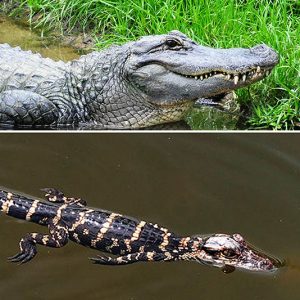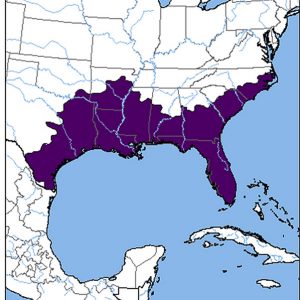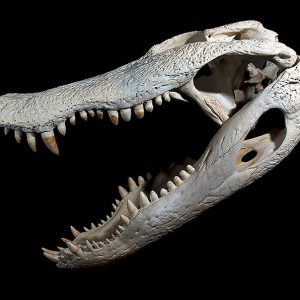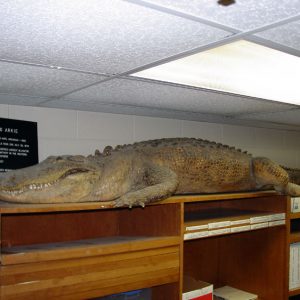calsfoundation@cals.org
American Alligator
The American alligator (Alligator mississippiensis) belongs to the class Reptilia, order Crocodylia, superfamily Alligatoroidea, and family Alligatoridae. There are seven species in the family endemic to the New World tropics, with an eighth species occurring in the warmer temperate regions of China. The American alligator is endemic to the southeastern coastal plain of the United States, where it inhabits freshwater wetlands such as streams, reservoirs, ponds, lakes, coastal marshes, bayous, oxbows, and cypress swamps associated with larger rivers in parts of Alabama, Arkansas, Florida (and some Florida Keys), Georgia, Louisiana, Mississippi, North Carolina, Oklahoma, South Carolina, Texas, and Virginia; it also occurs in the lower Rio Grande Valley of Texas south of San Antonio, and farther south into the thornscrub of Tamaulipas, Mexico, but was likely introduced there. In 2018, there were several confirmed sightings of gators that had moved north into western Tennessee. In Arkansas (the northwestern edge of its range), A. mississippiensis is found in the Gulf Coastal Plain and most of the southwestern part of the state, but the species has lost more than seventy percent of its wetland habitat since the 1780s. This crocodilian was relocated from stock in Louisiana by the Arkansas Game and Fish Commission from 1972 to 1984 at several locales in the state where it formerly occurred. Two sites in Arkansas where alligators are common are Arkansas Post’s wetlands near Dumas (Arkansas County) and also the marshes of Millwood State Park, located near Ashdown (Little River County).
While A. mississippiensis prefers still and quiet freshwaters, it sometimes roams into estuaries containing brackish water; however, it is less tolerant of saltwater than caimans (Caiman spp. and Melanosuchus niger) and more specifically crocodiles (Crocodylus spp.), as the salt glands on its tongue do not function.
The American alligator was initially described in 1801 by François Marie Daudin (1776‒1803) as Crocodilus mississipiensis. Jean Léopold Nicolas Frédéric, Baron Cuvier, known as Georges Cuvier (1769‒1832), erected the genus Alligator in 1807. The superfamily Alligatoroidea includes all crocodilians (fossil and extant) that are more closely related to the American alligator than to either the Nile crocodile (Crocodylus niloticus) or gharial (Gavialis gangeticus). Members of this superfamily first arose in the late Cretaceous. Leidy’s crocodile (Leidyosuchus) is the earliest known genus of middle Campanian age (76–65 million years ago) from the Dinosaur Park Formation, Alberta, Canada. In addition, fossil alligatoroids have been found throughout Eurasia, given that land bridges across both the Bering Strait and the North Atlantic connected North America to Eurasia during the Cretaceous (145–66 million years ago), Paleogene (66–23 million years ago), and Neogene (23–3 million years ago) periods. There is a good Pleistocene fossil record in Texas. Alligators and caimans split in North America during the late Cretaceous (101–66 million years ago), and the latter reached South America by the Paleogene. The Chinese alligator (Alligator sinensis) probably descended from a lineage that crossed the Bering land bridge during the Neogene. The modern American alligator is well represented in the fossil record of the Pleistocene. In 2016, a Miocene fossil alligator’s skull was found in Marion County, Florida. Unlike those of other extinct alligator species of the same genus, this specimen was virtually indistinguishable from that of the modern American alligator. This alligator and the American alligator are now considered to be sister taxa, meaning that the A. mississippiensis lineage has existed in North America for over eight million years.
The American alligator is one of two living species in the genus within the family Alligatoridae; it is larger than the other extant alligator species, the critically endangered Chinese alligator (Alligator sinensis), found only in the southern area of the Yangtze River, China. Domestic American alligators range from long and slender to short and robust, possibly due to variations in factors such as growth rate, diet, and climate. American alligators have broad snouts with seventy-four to eighty teeth. When the jaws are closed, the edges of the upper jaws cover the lower teeth, which fit into the jaws’ hollows. Like the spectacled caiman (Caiman crocodilus), this species has a bony nasal ridge, though it is less prominent. Dorsally, adult American alligators may be olive, brown, gray, or black in color, while their undersides are cream-colored. Compared to crocodilians, the Alligatoridae have broader snouts and feed less upon terrestrial prey items. It is distinguished from the sympatric American crocodile (Crocodylus acutus) by its broader snout, with overlapping jaws and darker coloration, and is less tolerant of saltwater but more tolerant of cooler climates than the American crocodile, which is found only in tropical climates.
One of the unique anatomical and physiological characteristics of crocodilians (including the American alligator) is a four-chambered heart, a trait shared with birds and mammals. Vertebrates with four-chambered hearts are able to separate oxygenated and deoxygenated blood. In addition, there is another advantage that has to do with blood pressure. A full separation between the two systems (blood to and from the lungs and blood to and from the body) means crocodilians can maintain a high-pressure blood system, actively pumping fully oxygenated blood to their muscles without doing damage to the tiny, delicate blood vessels in the lungs.
The American alligator is a relatively large species of crocodilian. On average, it is the second-largest species in the Alligatoridae family, behind only the black caiman (Melanosuchus niger). As opposed to many mammals, for which size eventually diminishes with old age, healthy American alligators may continue to grow throughout their lives, and the oldest specimens are the largest. Male American alligators reach an expected maximum size of up to 4.6 m (15 ft., 1 in.) in length, weighing up to 453 kg (999 lb.), while females reach a maximum of 3 m (9 ft., 10 in.). Typically, mature male A. mississippiensis measure 3.4 to 4.6 m (11.2 to 15.1 ft.) in length, and can weigh up to 453 kg (999 lb.). Mature females are smaller, measuring 2.6 to 3 m (8.5 to 9.8 ft.) in length with a body weight of up to 91 kg (201 lb.). The largest reliable record size is an individual measuring 4.5 m in length and weighing 458 kg, harvested in 2014 in Wilcox County, Alabama. The largest American alligator ever killed in Florida was 5.3 m (17 ft., 5 in.). The largest alligator ever harvested in Arkansas was four meters long (13 ft., 10 in.) and over 630 kg (1,380 lbs.). The American alligator may live up to fifty years in the wild and even longer in captivity.
In Arkansas, modern-day alligator hunting began in 2007 after approval from the U.S. Fish and Wildlife Service. Hunters get the opportunity to hunt (during the night) by either using a handheld snare or harpoon (and dispatch by gunshot) only after applying for and getting their permit drawn each year by the Arkansas Game and Fish Commission. Arkansas hunters harvested ninety-four alligators during the 2017 alligator-hunting season. In addition to the added sporting opportunity for Arkansans, alligator hunting helps control alligator populations and reduce complaints of nuisance gators, the result of alligators roaming into populated areas.
Juvenile and adult American alligators are apex predators and consume fish, amphibians, reptiles (especially turtles), waterfowl, and mammals; hatchlings feed mostly on invertebrates such as crayfish, insects, insect larvae, snails, spiders, and worms. They are opportunistic predators whose diet is determined mostly by both the size and age of the alligator and the size and availability of prey. Among native mammals, stomach contents show that nutria, opossums, beaver, muskrats, and raccoons are some of the most commonly eaten species. Other mammals may be consumed, even feral wild boars and large white-tailed deer, but these are not normally part of the diet. Occasionally, domestic animals, including dogs, cats, and calves, are taken as available, but are secondary to wild and feral prey. Other prey items, including snakes, lizards, and various invertebrates (blue crabs), are occasionally eaten by adults. Water birds, such as herons and egrets, storks, and various ducks, as well as large dabbling rails such as coots or gallinules, are taken when possible. Occasionally, adult birds are grabbed and eaten as the prey of American alligators, but most bird predation is directed at unsteady fledgling birds in late summer as young birds attempt to make their first flights near the water’s edge. In marine and brackish habitat, American alligators have been documented killing and eating sharks (bonnethead, lemon, and nurse) and Atlantic stingrays. Interestingly, in the 2000s, when the invasive Burmese python (Python bivittatus) was first reported from the Everglades, American alligators were recorded preying on them, possibly controlling populations and thus preventing the invasive species spreading northward. American alligators and other crocodilians have been reported to also eat fruit directly from the trees such as elderberries, wild grapes, and citrus fruits.
About eighty percent of young alligators are eaten by predators such as birds, raccoons, bobcats, otters, snakes, largemouth bass, and even by larger alligators. There are few natural predators of adult alligators, but large felids such as mountain lions (Florida panther) sometimes kill them, as do invasive Burmese pythons.
Fatal attacks on humans are rare but do occur in the southeastern United States. American alligator bites can be quite serious due to the reptile’s sheer bite force and the risk of infection. Even with medical treatment, an American alligator bite may still result in a fatal bacterial infection. As the human population increases and encroaches on the native habitat of alligators, it is only natural that attacks and nuisance complaints will increase.
Alligators play an important role as ecosystem engineers (keystone species) in wetland marsh ecosystems through the creation of alligator holes, which provide both wet and dry refuges for other organisms such as invertebrates, fish, amphibians, turtles, snakes, birds, and mammals.
Throughout the year, in particular during the breeding season, American alligators have a throaty bellowing roar to declare territory and attract suitable mates. Both sexes bellow loudly by sucking air into their lungs and blowing it out in intermittent, deep-toned roars. They can also perform specific vocalizations to signal distress or threaten competitors, often also slapping tails on the surface of water. Juvenile American alligators can perform a high-pitched “yelping” hatchling call to alert their mothers when they are ready to emerge from the nest. Juveniles also make a distress grunt or chirping call to alert their mothers if they are being threatened. In addition to bellowing, American alligators can growl, hiss, or cough to threaten others and declare territory.
The reproductive season of A. mississippiensis begins in the spring. On those nights, American alligators gather in large numbers for group mating. The female builds a nest of vegetation, sticks, leaves, and mud in a sheltered spot in or near the water. After she lays twenty to fifty white eggs, about the size of a duck or goose egg, she covers them with more vegetation, which heats as it decays, helping to keep the eggs warm. The female remains near the nest throughout the sixty-five-day incubation period, protecting it from intruders. Eggs hatched at a temperature of 34°C (93°F) or greater become males, while those at a temperature of 30°C (86°F) or less become females. When the young begin to hatch and yelp, the mother quickly digs them out of their nest and carries them in her mouth to the water. After hatching, the young gather into pods and are guarded by their mother by keeping in contact with her through their vocalizations. Young American alligators grow 7.6 to 20.3 cm (3 to 8 in.) a year and mature at about 1.8 m (6 ft.). Mother American alligators eventually become more aggressive toward their young, which encourages them to disperse.
The American alligator is currently listed as a Species of Least Concern by the International Union for Conservation of Nature. However, it has not always been that way. In 1967, as a result of overhunting, the pet trade, and killing as a potential predator of livestock, the American alligator was listed as an endangered species (under a law that was the precursor Endangered Species Act of 1973), since it was believed to be in danger of extinction throughout all or a significant portion of its range. Subsequent conservation efforts allowed their numbers to increase, and the species was delisted in 1987, as it was considered to be fully recovered. The U.S. Fish and Wildlife Service still strictly regulates the legal trade in American alligators and their products to protect still-endangered crocodilians that may be passed off as American alligators during trafficking.
As well as organized state hunting seasons for American alligators, they are harvested for their skins and meat. Alligator farming is a large, growing industry in several states including Georgia, Louisiana, Florida, and Texas. These states produce a combined annual total of some 45,000 alligator hides. In addition, the market for alligator meat is growing, and about 140,000 kg (300,000 lbs.) of meat is produced annually and sold in many restaurants in the south.
In terms of parasites, American alligators harbor a suite of protists and helminths, including haemogregarines, coccidians, trematodes, cestodes, nematodes, and pentastomes. A pentastome parasite that causes sebekiosis in captive alligator hatchlings has been reported to produce anorexia, weight loss, respiratory distress, and ultimately death. A new species of leech, Placobdella siddalli, was described from A. mississippiensis from Mississippi. As of 2019, there have been no reports of parasites of American alligators in Arkansas.
For additional information:
Allsteadt, J., and J. W. Lang. “Sexual Dimorphism in the Genital Morphology of Young American Alligators, Alligator mississippiensis.” Herpetologica 51 (1995): 314–325.
Barbee, M. 2014 Alligator Management Report. Little Rock: Arkansas Game and Fish Commission, 2015.
Bartlett, Richard D., and Patricia Bartlett. A Field Guide to Texas Reptiles and Amphibians. Houston: Gulf Publishing Company, 1999.
Conover, M. R., and T. J. Dubow. “Alligator Attacks on Humans in the United States.” Herpetological Review 28 (1997): 120–124.
Dinets, Vladimir L. “Nocturnal Behavior of the American Alligator (Alligator mississippiensis) in the Wild during the Mating Season.” Herpetological Bulletin 111 (2010): 4–11.
Dixon, James R. Amphibians and Reptiles of Texas with Keys, Taxonomic Synopses, Bibliography, and Distribution Maps. 3rd ed. College Station: Texas A&M Press, 2013.
Eversole, Cord B., Scott E. Henke, David B. Wester, Bart M. Ballard, and Randy L. Powell. “Time of Night as a Technique for Conducting American Alligator (Alligator mississippiensis) Surveys.” Herpetological Review 46 (2015): 520–523.
Gabrey, S. W. “Demographic and Geographic Variation in Food Habits of American Alligators (Alligator mississippiensis) in Louisiana.” Herpetological Conservation and Biology 5 (2010): 241–250.
GatorWise. https://www.gatorwise.org/ (accessed June 6, 2025).
Harding, Brett E., and Barbara C. Wolf. “Alligator Attacks in Southwest Florida.” Journal of Forensic Sciences 51 (2006): 674–677.
Hastings, Robert W. The American Alligator: Abused, Protected, Restored. Lafayette: University of Louisiana Press, 2025.
Hazen, Terry C., John M. Aho, Thomas M. Murphy, Gerald W. Esch, and Gerald D. Schmidt. “The Parasite Fauna of the American Alligator (Alligator mississippiensis) in South Carolina.” Journal of Wildlife Diseases 14 (1978): 435–439.
Heck, Berlin A. “The American Alligator (Alligator mississippiensis) in Oklahoma with Two New Early Records.” Proceedings of the Oklahoma Academy of Science 86 (2006): 17–21.
Hibbitts, Troy D., and Terry L. Hibbitts. Texas Turtles & Crocodilians: A Field Guide. Austin: University of Texas Press, 2016.
Hunt, R. H., and M. E. Watanabe. “Observations on the Maternal Behavior of the American Alligator, Alligator mississippiensis.” Journal of Herpetology 16 (1982): 235–239.
Janke, A., and U. Arnason. “The Complete Mitochondrial Genome of Alligator mississippiensis and the Separation between Recent Archosauria (Birds and Crocodiles).” Molecular Biology and Evolution 14 (1997): 1266–1272.
McAllister, Chris T., and Steve J. Upton. “The Coccidia (Apicomplexa: Eimeriidae) of Crocodylia, with Descriptions of Two New Species from Alligator mississippiensis (Reptilia: Alligatoridae) from Texas.” Journal of Parasitology 76 (1990): 332–336.
McCallum, Malcolm L., Stanley E. Trauth, Robert G. Neal, and Vernon Hoffman. “A Herpetofaunal Inventory of Arkansas Post National Memorial, Arkansas County, Arkansas.” Journal of the Arkansas Academy of Science 57: (2003): 122–130. Online: at https://scholarworks.uark.edu/cgi/viewcontent.cgi?article=1606&context=jaas (accessed September 11, 2019).
Platt, Steven G., Ruth M. Elsey, Thomas Rainwater, and Mike Fredenberg. “A Critical Analysis of a Historic Size Record for the American Alligator.” Southeastern Naturalist 17 (2018): N60–N63.
Powell, Robert, Roger Conant, and James T. Collins. Peterson Field Guide to Reptiles and Amphibians of Eastern and Central North America. 4th ed. Boston: Houghton Mifflin Harcourt, 2016.
Richardson, Dennis J., William E. Moser, Charlotte I. Hammond, Eric Lazo-Wasem, Chris T. McAllister, and Eric E. Pulis. “A New Species of Leech of the Genus Placobdella (Hirudinida, Glossiphoniidae) from the American Alligator (Alligator mississippiensis) in Mississippi, USA.” ZooKeys 667 (2017): 39–49.
Ross, C. A., and Carl H. Ernst. “Alligator mississippiensis (Daudin), American Alligator.” Catalogue of American Amphibians and Reptiles 600 (1994): 1–14.
Saalfeld, D. T., C. W. Conway, and G. E. Calkins. “Food Habits of American Alligators (Alligator mississippiensis) in East Texas.” Southeastern Naturalist 10 (2011): 659–672.
Saalfeld, D. T., K. K. Webb, C. W. Conway, C. E. Calkins, and J. P. Duguay. “Growth and Condition of American Alligators (Alligator mississippiensis) in an Inland Wetland of East Texas.” Southeastern Naturalist 7 (2008): 541–550.
Scott, Timothy P. Steve R. Simcik, and Thomas M. Craig. “Endohelminths of American Alligators (Alligator mississippiensis) from Southeast Texas.” Journal of the Helminthological Society of Washington 64 (1997): 258–262.
Smith, Geoffrey D., Ginny L. Adams, and Stephen A. Dinkelacker. “Important Habitat Characteristics for American Alligators (Alligator mississippiensis) on the Edge of Their Range.” Herpetological Conservation and Biology 11 (2016): 72–79.
Trauth, Stanley E., Henry W. Robison, and Michael V. Plummer. The Amphibians and Reptiles of Arkansas. Fayetteville: University of Arkansas Press, 2004.
Vilet, Kent. “Social Displays of the American Alligator (Alligator mississippiensis).” American Zoology 29 (1989): 1019–1031.
Watt, Christopher L., Philip A. Tappe, and Mark E. Roth. “Concentrations of the American Alligator Populations in Arkansas.” Journal of the Arkansas Academy of Science 56 (2002): 243–249. Online at: https://scholarworks.uark.edu/cgi/viewcontent.cgi?article=1663&context=jaas (accessed September 11, 2019).
Woodward, A. R., J. H. White, and S. B. Linda. “Maximum Size of the Alligator (Alligator mississippiensis).” Journal of Herpetology 29 (1995): 507–513.
Chris T. McAllister
Eastern Oklahoma State College










Comments
No comments on this entry yet.